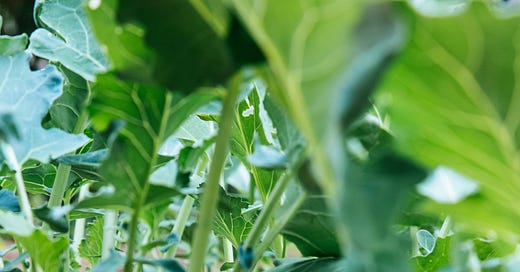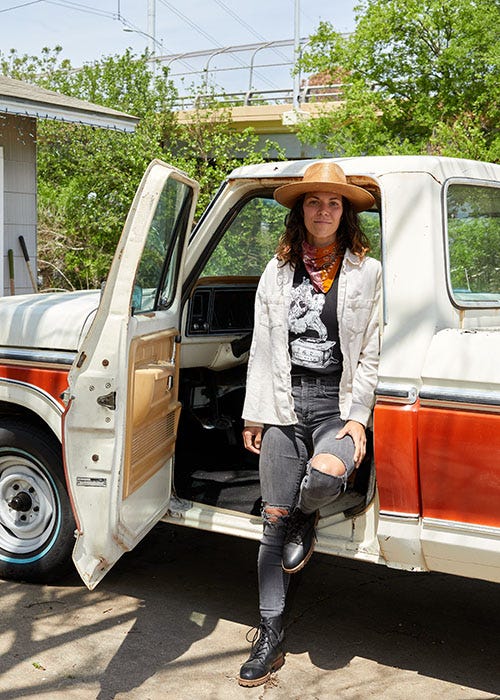Welcome back to The Link, a bi-weekly circularity newsletter making the connection between regenerative farming and you, every other Tuesday.
Was it just me, or did anyone else survive the pandemic by binge watching British celebrity Master Gardener Monty Don on his lesser known gardening show, “Big Dreams, Small Spaces”? OK well if you missed it, the synopsis is as follows: the very jaded and knowledgeable gardener rings the doorbell at random Brits flats and houses in a wrinkled linen shirt and his blue French worker’s coat—looking as pissed off as can be for reasons unknown (perhaps he was rudely interrupted from nap time on the set by some polite show runner?) to be invited in to guide amateur gardeners on a journey through transforming their tiny backyard spaces into vibrantly gorgeous gardens. Spoiler alert: his insults and disappointment in these gardeners at the end of every episode is almost as searing as the read challenges on Ru Paul’s Drag Race (highly recommend watching both shows, btw). That said, I was surprised that no one ever wanted to grow their own food in any of the episodes, but maybe planting fairy gardens is something more worthwhile in ways I will never know.
Anyways all this talk of inflation and the high price of grocery bills lately makes me wonder if the victory garden will ever return in mass? What could the future of food production look like in North America, if we actually recognize and support the importance of food sovereignty as a universal collective? This is of course, already taking place like patchwork in communities across the country, whether it be a food forest, a community garden, a farm, or a neighbors backyard where food access is shared as a commons.
Taking a sprinkle of (non-pissed off) inspiration from Big Dreams, Small Spaces myself, I wanted to ground myself into the realities of growing food in urban places for surprisingly generous food production yields besides the obvious community garden—whether in an abandoned parking lot, a 400-square foot shared backyard or even a front yard teeming with Bermuda grass. Naturally, I had to ask Trisha Bates, the person to talk to on this topic about what she thought might be possible.
She’s an urban farm consultant here in Austin who is on a mission to “raise the hype” on growing your own food and believes that in doing so, it’s an act of rebellion and a lifelong pursuit against fast food sources. She’s the co-founder of Field Guide Festival, a food system festival that celebrates the connection between Central Texas farmers and chefs and the links between them, which is happening this Saturday, April 20th, btw, and there’s still tickets, so get them while you can! Originally from the Midwest, Trisha grew up in a family of farmers who know what it means to grow food in large production and small production, too.
Trisha considers herself a lazy farmer, but is brilliantly strategic and making new life flourish. “I want to have as much chance of success with the least amount of effort when it comes to growing my own food,” she says. And if you’re interested in getting to know your local biome—the soil, the uniqueness of the ecological area you live in—and also want to cut down $$$ on your grocery bill with your neighbors, why not grow your own food if you are able to?
Trisha’s advice is simple: you never know what you’re gonna get until you try, and every space is different, so just go for it.
Grow Your Own Food Checklist
1. Location: Place your garden in a place with enough sunlight. Spend a day observing your space in the morning and make a note. Check on it every 2 hours and see how long you get sun there. Most fruiting vegetables need 6-8 hours of sunlight, but for things like lettuces, which aren’t in the ground as long, they can get 4-6 hours of sun and be just fine.
2. Water: Water is a sacred resource. Make sure you know where it’s coming from and ideally somewhere near you. Thank it and use it wisely.
3. Soil: It’s the most important piece of growing. Use organic if you can get it. Use a trusted source to find it. Look for a good texture (sandy + clay combo) and add some compost in it. The sandier side soil texture will give you good drainage, and you can always add more compost for moisture retention.
4. Tasty Things: What to plant for food production with volume in mind: radishes, turnips, beets, carrots, lettuce, herbs, kale, squash, cucumbers, peppers, and tomatoes.
“One of the best pieces of advice I was given that’s true of life and true of growing food, too: you should always take extra care to water the edges. It’s true with a raised bed or in-ground garden, in the greenhouse with your seedlings, too. If you take care of the margins, the center is always going to have enough.”
Here’s to watering your edges, wherever you need it this season.
If you want to learn more about Trisha’s work in Central Texas and beyond, check out her site, Urban American Farmer. Subscribe to her substack, Urban American Farmer, for stories about food and agriculture.





